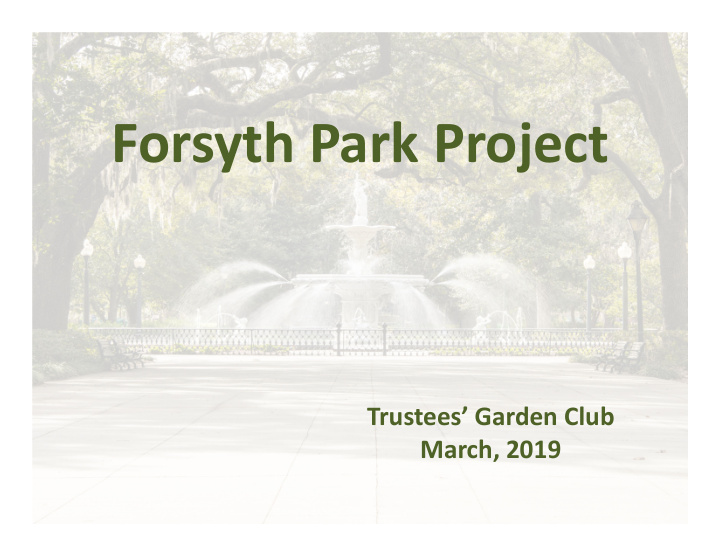



Forsyth Park Project Trustees’ Garden Club March, 2019
Park History • Established in 1841 • Older than Central Park in New York and may be the oldest public park in the country • Historically significant landscape with a remarkable degree of historic integrity • One of the premier examples of public park planning in the United States
Project Mission • To build a foundation of research and community involvement to protect the historic assets of and to manage change in Forsyth Park. • To develop a Master Plan for Forsyth Park in partnership with the City of Savannah and the broader community.
Project Elements • Overarching Values and Guidelines for Treatment of Forsyth Park (completed) • Cultural Landscape Report (Q‐2, 2019) • Master Plan (Timing of Completion TBD) • National Historic Landmark/National Register Designation
Park Master Plan • A Master Plan for Forsyth Park will create a vision for the future of the park and will be the result of a well‐ considered, inclusive process that respects both history and change. • The plan can be implemented over a number of years by coordinating the efforts of city officials and departments, community members and potentially non‐profit partners.
Why Is A Master Plan Needed? • Provides a tangible assessment of the current condition of the park and outlines opportunities for future infrastructure, educational and other enhancements in the future • Articulates a common vision for the park’s future with a clear set of recommendations and strategies for managing change • Identifies challenges and opportunities in the park and provides guidelines for decision‐making
Master Plan Components • Extensive Community Outreach and Education • Site Analysis and Assessment • Recommended Treatment • Implementation Strategies
Centennial Park ‐ Nashville • Park is similar in age to Forsyth Park • The plan honors the park’s with historic structures and green history while accommodating space. modern uses that will stand the test of time. • One of the busiest and most frequented • Input was sought from the parks in the city. community through series of well‐attended public sessions, resulting in a plan that reflects the users’ desires. • Elements include landscaping, in‐depth analysis of storm water management, parking, programming, utilities, sidewalks, facilities and buildings.
Master Planning Process • MOU between the City and Trustees’ Garden Club • Develop RFP with City input and release to prospective planning firms • Retain services of planning firm • Develop initial draft of plan
Master Planning Process (The Importance of Community Involvement) • Host meetings in all districts to allow the community to develop a shared vision for the park that is inclusive and will provide both consistency and flexibility so that the park evolves to meet current needs while honoring its deep history and iconic spaces.
Keys to Success • Broad‐based community support and involvement • Shared understanding of the park’s challenges and the needs of the community • Collaborative long‐term commitment of stakeholders to achieving the goals and vision identified in the plan and to obtaining funding to execute them • Buy in and support of City government in the form of MOU
Forsyth Park Project Trustees’ Garden Club March, 2019
Recommend
More recommend